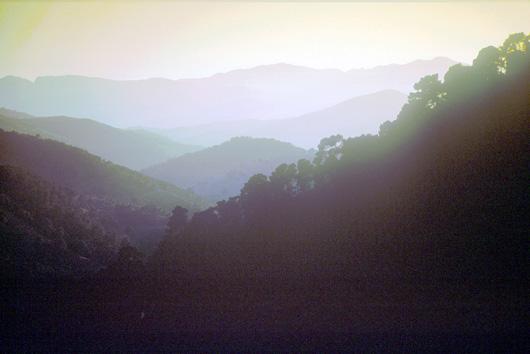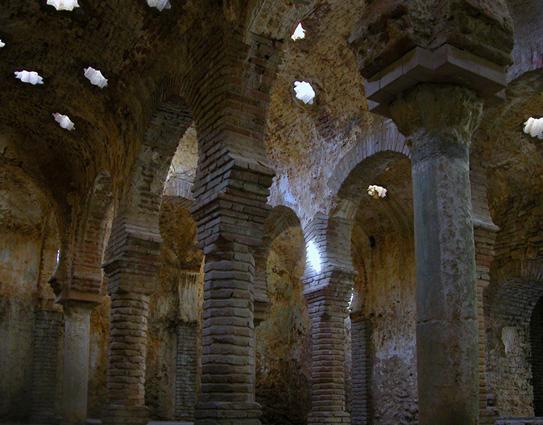Ronda

Ancient Ronda is a colourful tapestry woven from a skein of tangled threads which make it one of the most interesting cities in all Andalusia. The landscape, the layout of the town, its history, the romantic legend of its bandits with their evocative names, the cradle of bullfighters and artists whose names have gone down in history: all this makes Ronda a unique city.
The list of outstanding men of letters who have fallen captive to the charms of this city can be traced from the earliest texts down to the present day. Pliny, al-Motámid the poet-king of Seville, al-Idrisi, Ibn al-Jatib, Vicente Espinel, Rilke, Juan Ramón Jiménez and Juan Goytisolo are just a few of the long line of authors who have written eloquent pages about Ronda; a place where –if the locals are to believed– it rains upwards, and where birds fly beneath your feet as you lean out over the Tajo gorge.
The city inveigles you to take a leisurely stroll through its streets, absorbing every detail of this ancient Arab “medina” on the south bank of the Guadalevín river, whose walls are still partially standing. You can cross the Puente Nuevo (“new bridge”) and wander around the Alameda del Tajo, stopping at every odd corner and historic monument, and then restore your strength in one of the restaurants offering an abundant selection of dishes from the local cuisine.
The town itself is divided into three clearly distinct areas: the city, or old Arab Medina, which is the most important from the historical point of view; the neighbourhood of San Francisco, separated by city Walls, and the Mercadillo neighbourhood, which is on the other side of the Guadalevín river.
History
Some historians believe its origins date from the Bastuli Celts, who named the place Arunda. The Romans settled in Arunda and in Acinipo (also known as Ronda La Vieja, or “Old Ronda”). Pliny and Ptolemy mention Acinipo as one of the main cities in the Roman province of Baetica. Its most noteworthy ruins include the theatre, among the most important in Roman Spain. In Arunda the Romans built the castle of Laurus (or Laurel) mentioned by Pliny in his Natural History as Arunda Laurus, on which the Muslim fortress was subsequently built.
After the dark Visigoth period, Ronda regained its importance under the Muslim domination, when Arunda became known as Izna Rand Onda. From the 8th to the 15th century it was one of the most important fortresses in Andalusia. During the emirates of Al Mondhir and Abdallah ben Mohamed (886-912) the Ronda mountains became the scene of a major rebellion by the Muladi –old Christians converted to Islam– led by Omar Ben Hafsún, the descendent of a rich Visigoth family. Omar established a stronghold in Bobastro – the site of which has still not been ascertained beyond doubt, but which is thought to be in or near the Ronda mountains– and from here he gained control of a large stretch of eastern Andalusia, with major towns such as Archidona, Ecija, Baena and Lucena under his command. His dominions and prestige among Muladi Muslims rose continually until his defeat at Poley (Aguilar) in 891, after which Omar sought an alliance with the Arabs in the north of Africa and the Christians in the north of the Spanish peninsula. He ultimately converted to Christianity (a doctrine which made such a strong impression on one of his daughters that she is today included in the calendar of Catholic saints with the name of Santa Argentea), which lost him the trust of many of his Muladi followers, although at his death in 916, the stronghold at Bobastro was still standing. On the fall of Bobastro (928), after the defeat of Omar’s sons by the first Caliph Abd-Al Rahman III, the town became part of the Caliphate of Cordoba. After the disappearance of the Caliphate of Cordoba came the taifa, or Muslim kingdom, ruled by the Berber family of Banu Ifrán (the sons of Ifrán); at the end of the 11th century it was annexed to the kingdom of Seville by Ibn al-Abbad, after the ruthless execution of the taifa’s rulers in Ronda.
In the 13th century, Abenamar – the famous leader and founder of the Nasrid dynasty– surrendered it to the Marinids from Morocco, and it was ruled by the government in north Africa until 1439, when it became part of the Nasrid kingdom of Granada.
The Arab presence can still clearly be seen in the appearance and layout of the city of Ronda, which is arguably the best conserved in all Andalusia.
After a long struggle the city was finally recaptured by the Catholic Monarchs in 1485. As a consequence of the fierce resistance by the Muslims, who never surrendered but were vanquished by the Christian troops, the city was divided up among the Castilian nobility.
The 1449 decree which ordained the forcible conversion of Spanish Muslims sparked a series of uprisings in the mountain area around the town, and Ronda became the centre of operations from which attempts were made to suppress the revolt. In 1571, the Muslims were finally expelled, although for years there remained centres of resistance within the cover of the steep and rocky mountains.
In the 18th century, Ronda underwent a substantial economic boom. The city, formerly divided by the Tajo gorge, was joined in 1751 when the famous Puente Nuevo bridge was built.
During the French invasion there was an active resistance movement in the mountain region around Ronda. On their retreat, the French destroyed part of the castle and other fortifications in the city.
Famous inhabitants
Vicente Espinel, writer.
Pedro Romero, bullfighter.Antonio Jiménez González, painter.
Antonio Ordóñez, bullfighter.
Francisco Giner de los Ríos, intellectual and teacher.

- Max 7
- Min 5
- Max 44
- Min 41
- °C
- °F











































